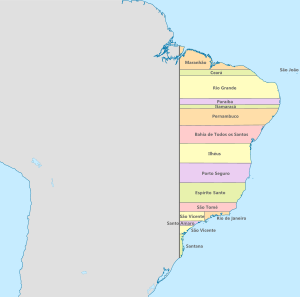Captaincy of São Vicente
The Captaincy of São Vicente (1534–1709) was a land grant and colonial administration in the far southern part of the colonial Portuguese Empire in Colonial Brazil.
History
In 1534 King John III of Portugal granted the Captaincy to Martim Afonso de Sousa, a Portuguese admiral. Sousa had founded the first two permanent Portuguese settlements in Brazil in 1532: São Vicente (near the present port of Santos) and Piratininga (later to become São Paulo).
Martim Afonso received two tracts of land:
- one centered on the settlement of São Vicente, extending along the coastline from Cananeia to Bertioga (within present-day São Paulo state)
- the other extended from Parati to Cabo Frio (within present-day Rio de Janeiro state).
Although divided into two lots - separated by the Captaincy of Santo Amaro - together these territories formed the Captaincy of São Vicente.
In 1681 the São Paulo settlement succeeded São Vicente as the capital of the captaincy, and the original name of the latter gradually fell into disuse.
São Vicente became the only captaincy to flourish in southern Portuguese colony of Brazil. It ultimately gave rise to São Paulo state and provided the base for the Bandeiras to expand Portuguese America to the west of the Tordesilhas Line.
Territorial evolution of the Captaincy of São Vicente (1534–1709)
The Captaincy of São Vicente in Southern Brazil:
 1534
1534
Capitanias hereditárias - the two bottommost yellow stripes denote the Captaincy of São Vicente 1709
1709
São Paulo at its greatest extent, in pale yellow
See also
- Captaincies of Brazil
- Portuguese Colonial Brazil-related topics
References
Cited texts
- Lockhart, J.(1983), Early Latin America: A History of Colonial Spanish America and Brazil. Cambridge University Press ISBN 978-0521299299
- Baptista, S.(2008) Chaptory 4: Historical Context Forest Recovery and Just Sustainability in the Florianopolis City-region UMI 3349866